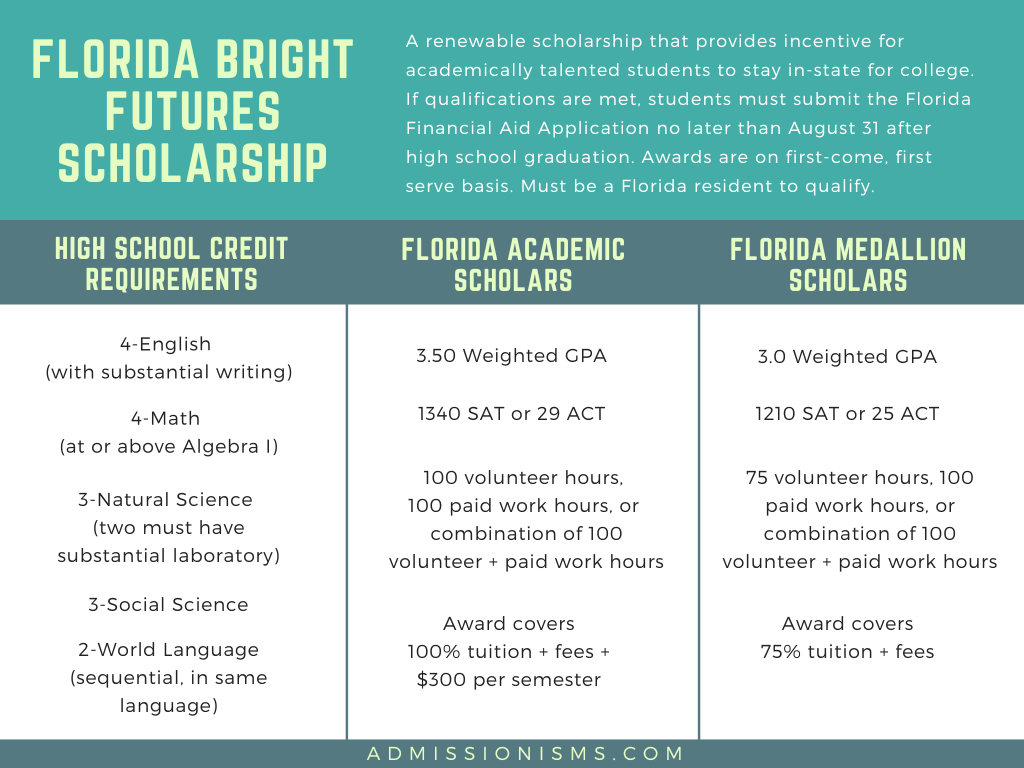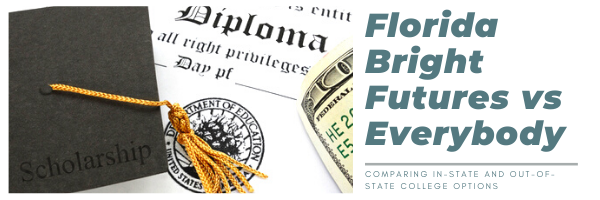
Listen up and pull up a chair, if you are a resident in the state of Florida. Us Floridians have a wonderful gift in the name of college affordability. And it is called the Florida Bright Futures Scholarship.
Florida Bright Futures, created in 1997, provides a major incentive for top academically-performing students to stay in-state for college. It pays for the costs of college tuition for qualifying students. This scholarship award is also renewable. As long as GPA and earned credit hours stay above the cutoff, students can continue to apply the scholarship to cover tuition and applicable fees.
The Florida Department of Education publishes a yearly handbook covering details of how to apply and eligibility and renewal requirements, but here is the “quick and dirty” that applies to most high school students, especially when strategizing how to best meet the qualifications. (Also, meeting with your high school counselor is a great place to start!).
Four Scholarship Competitions
There are 4 scholarship competitions – each with their own specific eligibility criteria. While the Florida Academic Scholars (FAS) and Florida Medallion Scholars (FMS) focus on the traditional 4-year college degree track, the Gold Seal Vocational Scholars and Goal Seal CAPE Scholars programs focus on vocational or career/technical education (CTE) track.
Many CTE programs require a year or two of coursework, earning an associates degree or certificate, before being able to transition directly into the workforce. Examples include paralegal, electrician, physical therapy assistant, etc.
As an independent college counselor, living in the state of Florida, most of the high school students that I’ve worked with qualify for the academic-based scholarship programs. So I will focus mostly on those.
Generally speaking, to qualify, students must achieve a 3.0+ weighted GPA, complete a set of 16 required high school credits, score at or above a specific SAT/ACT cutoff, and perform a documented number of community service hours.
Florida Academic vs Florida Medallion Scholars

Eligibility requirements updated with new volunteer and work hours qualifications for class of 2024 and beyond
The Florida Academic Scholar (FAS) award covers 100% of tuition and fees AND students will receive $300 to cover additional educational expenses across Fall and Spring semesters. Students can also receive the scholarship over summer semesters as well. In contrast, the Florida Medallion Scholars (FMS) award covers 75% of tuition and fees.
Both FAS and FMS awards can be applied toward virtually any in-state college. However, due to tuition cost differences for public vs private colleges, students are awarded a comparable amount to go to a private college.
The University of Florida is one of our state’s flagship public colleges. If tuition and fees amount to $8,000 per year, and the student is awarded the FAS, the entire $8,000 will covered by the Bright Futures Scholarship. (These are not real figures – just for the sake of example). In contrast, if the University of Miami is the top pick instead, students are able to apply a comparable amount toward the tuition at this private college. (Of course, the tuition is much more than $8000/year!).
Updated for 2023: Our Florida State Legislature passed some important changes to the Florida Bright Futures Scholarship program. Previously, students had to perform and document at least 100 community service hours to qualify for this scholarship award. Under the new update, students can split the difference between community service (volunteer) and paid work to meet the requirements. Great news for students who work! Please check with your local school district to determine which community service and paid work activities count and specific procedures for how to document hours. We’ve updated our graphic above accordingly to represent the most up-to-date information.
Special Qualification Status
National Merit Finalists/National Hispanic Scholars
The FL-DOE Bright Futures Handbook goes into this in great detail, but National Merit Finalists and Scholars and National Hispanic Scholars qualify for the scholarship, independent of their SAT/ACT scores, so long as community service/paid work hours are met. (Both of these special designations are determined from PSAT scores). Check with your student’s high school to see if and when they offer the PSAT.
International Baccalaureate (IB) and Advanced International Certificate of Education (AICE) Diploma Recipients
Another special circumstance to qualify includes receiving the International Baccalaureate (IB) diploma or the Advanced International Certificate of Education (AICE) diploma. They are eligible to receive Bright Futures regardless of their SAT/ACT scores. IB students typically sit for exams in the Spring of their Senior year of high school, so it will be after the school year wraps when you’ll know for sure whether you’re eligible for the FAS or FMS award. Florida colleges will update the financial aid award with the Bright Futures Scholarship, if applicable.
Homeschooled Students
Homeschooled students are Bright Futures Scholarship eligible, so long as they are registered with the district for 11th and 12th grades. (Of course, they also have to meet SAT/ACT and service requirements as well).
Real Life Case Study
A real-life example of when the details matter: One of my students is sitting at the top 11% of her graduating class. (Yes. 11%). She is enrolled in the IB program. She exceeds the GPA requirement. The IB curriculum has satisfied the high school credit hours requirements. It also takes care of the 100+ community service hour requirement. We started working together early in the Senior year of high school. She had already qualified for the FMS award.
Despite taking the SAT several times, she hasn’t exceeded the cutoff necessary to be awarded the FAS for full-tuition. She can keep taking the SAT to raise her score to qualify for the FAS award; she has until the end of the school year to qualify. However, the FAS award is hers for the taking if she passes her year-end IB exams and earns the diploma. See how this works?
Because she’s already qualified for the FMS, the lower tier award, I advised her to submit her application as soon as it became available: October 1. Since Bright Futures is awarded on a first come, first serve policy, we didn’t want to risk missing out.
Another update: Our young lady was eventually awarded the FAS award, netting 100% tuition paid to an in-state public college. After working together, she was admitted to every college on her list, including a few out-of-state choices. She opted to utilize her Bright Futures Scholarship money and start her college education at the University of South Florida. After graduation, she plans on pursing graduate school, and figured it was smart to save money here, because for grad school there are no guarantees of full tuition paid. (Smart girl).
Applying for Bright Futures
Did you catch that? You must apply for the Bright Future Scholarship. It is not automatically awarded. I often wonder how many students do not know to submit an application and/or apply late in the season after allocated funds have run out. To apply, head to the Florida Student Scholarship and Grant Programs website, set up a profile, enter your information, and then hit submit.
And then you wait. Late in Spring semester of Senior year, students can log into their profile for updates of early eligibility and award status notification. It won’t be until July or so, after final high school transcripts have posted, that you will receive final award status posted to your account.
Starting Early To Qualify
I advise all of my students to begin working toward meeting the Bright Futures requirements early. First stop is consulting with your high school counselor regarding course selection. If your student is still a Freshman or Sophomore in high school, you have plenty of time to ensure that you’re on track and each year you’re taking courses to satisfy the requirements. If you’re starting later, as a Junior or Senior, you’ve got to hustle to get the necessary coursework done.
It is also easy to accumulate the necessary community service hours, if you start early. Summers are an ideal time to spend volunteering. You won’t have to devote entire summers’ worth of time to acquire 75-100 hours, either. Survey your local neighborhood, community, or school for opportunities for volunteer work. Keep detailed records as you go for official documentation purposes.
As I alluded to before, a tricky area to navigate is the SAT/ACT test score requirement. Either standardized test is fine. Neither colleges nor Bright Futures prefer one type of test over the other. But I would recommend to begin testing early. Early Junior year is a great time to take the SAT or ACT for the first time. Whatever score you achieve will be your baseline. Now you have a ballpark of how many more points are needed to snag the Bright Future Scholarship. Spend time studying for the SAT/ACT and re-test at a later date. Although colleges will want your test scores earlier, you do have until virtually the end of 12th grade year to qualify for the Bright Futures Scholarship.
Bright Futures Scholarship requirements are subject to change on a yearly basis, as decisions are made by the State of Florida legislature, so check back frequently to make sure you have the latest, most up-to-date information about how to qualify, apply, and most importantly, renew the scholarship for all 4 years of your college education.
After Qualifying… What Next?
Come check out the second part of our Florida Bright Futures series… perhaps this is not the end of the road in deciding which college to attend, as was the case with several of our one-on-one clients. We present a few case studies that highlight questions of comparing Bright Futures options against out-of-state college options.

 6 Reasons To Start College Applications Before Senior Year
6 Reasons To Start College Applications Before Senior Year What To Do After College Deferral?
What To Do After College Deferral? The Science of College List Building
The Science of College List Building Getting Ready for College Admission in the Wake of Coronavirus
Getting Ready for College Admission in the Wake of Coronavirus